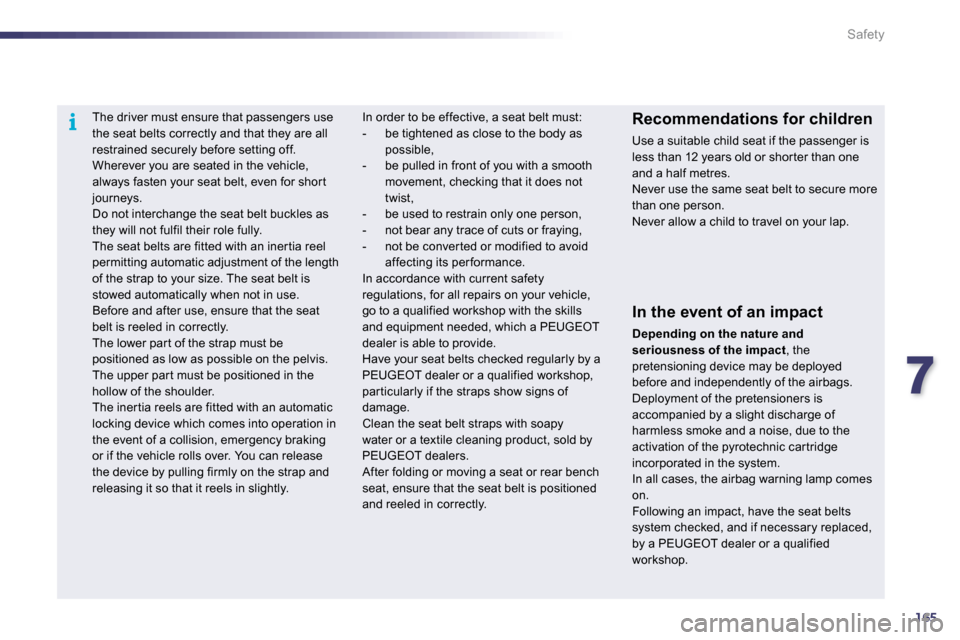2010.5 Peugeot 508 Dag child seat
[x] Cancel search: child seatPage 164 of 330

6151
!
Child safety
The incorrect installation of a child seat in a vehicle compromises the child's protection in the event of an accident. Remember to fasten the seat belts or the child seat harnesses keeping the slack relative to the child's body to a minimum, even for shor t journeys. When installing a child seat using the seat belt, ensure that the seat belt is tightened correctly on the child seat and that it secures the child seat firmly on the seat of your vehicle. Move the seat for wards if necessary. For optimum installation of the "for wards-facing" child seat, ensure that the back of the child seat is in contact with the back of the vehicle's seat and that the head restraint does not cause any discomfor t. If the head restraint has to be removed, ensure that it is stored or attached securely to prevent it from being thrown around the vehicle in the event of sharp braking.
Advice on child seats
As a safety precaution, do not leave: - a child or children alone and unsuper vised in a vehicle, - a child or an animal in a vehicle which is exposed to the sun, with the windows closed, - the keys within reach of children inside the vehicle. To prevent accidental opening of the doors and rear windows, use the "Child lock". Take care not to open the rear windows by more than one third. To protect young children from the rays of the sun, fit side blinds on the rear windows.
Children under the age of 10 must not travel in the "for wards-facing" position on the front passenger seat, unless the rear seats are already occupied by other children, cannot be used or are absent. Deactivate the passenger airbag when a "rear wards-facing" child seat is installed on the front seat. Other wise, the child would risk being seriously injured or killed if the airbag were to inflate.
Installing a booster seat
The chest par t of the seat belt must be positioned on the child's shoulder without touching the neck. Ensure that the lap par t of the seat belt passes correctly over the child's thighs. PEUGEOT recommends the use of a booster seat which has a back, fitted with a seat belt guide at shoulder level.
Page 165 of 330

152
!
Child safety
Your vehicle has been approved in accordance with the latest ISOFIX regulations . The seats, represented below, are fitted with regulation ISOFIX mountings:
"ISOFIX" mountings
There are three rings for each seat: - two rings A , located between the vehicle seat back and cushion, indicated by a label,
- a ring B , behind the seat, referred to as the TOP TETHER for fixing the upper strap.
This ISOFIX mounting system provides fast, reliable and safe fitting of the child seat in your vehicle. The ISOFIX child seats are fitted with two latches which are easily secured on the two rings A . Some also have an upper strap which is attached to ring B . To attach this strap, raise the vehicle seat's head restraint then pass the hook between its rods. Then fix the hook on ring B and tighten the upper strap.
Saloon
SW
The incorrect installation of a child seat in a vehicle compromises the child's protection in the event of an accident.
For information regarding the ISOFIX child seats which can be installed in your vehicle, refer to the table showing the locations for installing ISOFIX child seats.
Page 166 of 330

6153
i
Child safety
ISOFIX child seat recommended by PEUGEOT a nd approved for
your vehicle
RÖMER Duo Plus ISOFIX (size category B1 )
Group 1: from 9 to 18 kg
Installed in the for wards-facing position. Fitted with an upper strap to be secured on the uppe r ring B , referred to as the TOP TETHER. Three seat body angles: sitting, reclining, lying.
This child seat can also be used on seats which are not fitted with ISOFIX mountings. In this case, it must be attached to the vehicle seat using the three point seat belt. Follow the instructions for fitting the child seat g iven in the seat manufacturer's installation guide.
Page 167 of 330

154
Child safety
Locations for installing ISOFIX child seats
In accordance with European Regulations, this table indicates the options for installing ISOFIX child sea ts on seats in the vehicle fitted with ISOFIX mountings. In the case of universal and semi-universal ISOFIX child seats, the ISOFIX size category, determined by a letter from A to G , is indicated on the child seat next to the ISOFIX logo.
Weight of the child /indicative age
Less than 10 kg (group 0)Up to approx. 6 months
Less than 10 kg(group 0) Less than 13 kg(group 0+)Up to approx. 1 year
From 9 to 18 kg (group 1)From approx. 1 to 3 years
Type of ISOFIX child seatShell"rear wards-facing""rearwards-facing""for wards-facing"
ISOFIX size categor yFGCDECDABB1
Front passenger seat Not Isofix
Saloon
Outer rear seats XIL- SUIL- SUIUF
IL- SU
Centre rear seat Not Isofix
SW
Outer rear seats XIL- SUIL- SUIUFIL- SU
Centre rear seat Not Isofix
Page 168 of 330

6155
Child safety
IUF: seat suitable for the installation of an I sofix U niversal seat, " F or wards-facing" secured using the top belt. IL- SU: seat suitable for the installation of an I sofix S emi- U niversal seat either: - "rear wards-facing" fitted with a top belt or a s tay, - "for wards-facing" fitted with a stay, - a shell seat fitted with an upper strap or a stay . For advice on securing of the top belt, refer to the paragraph "Isofix mountings".
X: seat not suitable for the installation of a child seat or shell for the weight group indicated.
Page 178 of 330

7165
i
Safety
The driver must ensure that passengers use the seat belts correctly and that they are all restrained securely before setting off. Wherever you are seated in the vehicle, always fasten your seat belt, even for shor t journeys. Do not interchange the seat belt buckles as they will not fulfil their role fully. The seat belts are fitted with an iner tia reel permitting automatic adjustment of the length of the strap to your size. The seat belt is stowed automatically when not in use. Before and after use, ensure that the seat belt is reeled in correctly. The lower par t of the strap must be positioned as low as possible on the pelvis. The upper par t must be positioned in the hollow of the shoulder. The iner tia reels are fitted with an automatic locking device which comes into operation in
the event of a collision, emergency braking or if the vehicle rolls over. You can release the device by pulling firmly on the strap and
releasing it so that it reels in slightly.
Recommendations for children
Use a suitable child seat if the passenger is less than 12 years old or shor ter than one and a half metres. Never use the same seat belt to secure more than one person. Never allow a child to travel on your lap.
In order to be effective, a seat belt must: - be tightened as close to the body as possible, - be pulled in front of you with a smooth movement, checking that it does not twist, - be used to restrain only one person, - not bear any trace of cuts or fraying, - not be conver ted or modified to avoid affecting its per formance. In accordance with current safety regulations, for all repairs on your vehicle, go to a qualified workshop with the skills and equipment needed, which a PEUGEOT dealer is able to provide. Have your seat belts checked regularly by a PEUGEOT dealer or a qualified workshop, par ticularly if the straps show signs of damage. Clean the seat belt straps with soapy
water or a textile cleaning product, sold by PEUGEOT dealers. After folding or moving a seat or rear bench
seat, ensure that the seat belt is positioned and reeled in correctly.
In the event of an impact
Depending on the nature and seriousness of the impact , the pretensioning device may be deployed before and independently of the airbags. Deployment of the pretensioners is accompanied by a slight discharge of harmless smoke and a noise, due to the activation of the pyrotechnic car tridge incorporated in the system.
In all cases, the airbag warning lamp comes on. Following an impact, have the seat belts system checked, and if necessary replaced, by a PEUGEOT dealer or a qualified workshop.
Page 180 of 330

7167
!
!
Safety
Deactivation
Only the passenger's front airbag can be deactivated: � with the ignition off , inser t the key in the n offpassenger airbag deactivation switch, � turn it to the "OFF" position, � then, remove the key keeping the switch in the new position.
According to version, this warning lamp comes on either in the instrument panel or in the seat belt and passenger's front airbag warning lamp display when the ignition is on and until the airbag is reactivated.
To assure the safety of your child, the passenger's front airbag must be deactivated when you install a "rear facing" child seat on the front passenger seat. Other wise, the child would risk being seriously injured or killed if the airbag were deployed.
If at least one of the two airbag warning lamps come on continuously, do not install a child seat on the front passenger seat. Have it checked by a PEUGEOT dealer or qualified workshop.
Reactivation
When you remove the child seat, turn the switch to the "ON" position to reactivate the airbag and so assure the safety of your front passenger in the event of an impact.
With the ignition on, this warning lamp comes on in the seat belt and passenger's front airbag warning lamp display for approximately one minute, if the passenger's front airbag is activated.
Operating fault
If this warning lamp comes on in the instrument panel, accompanied by an audible warning and a message in the instrument panel screen, contact a PEUGEOT dealer or a qualified workshop to have the system checked. The airbags may no longer be deployed in the event of a serious impact.
If this warning lamp flashes, contact a PEUGEOT dealer or a qualified workshop. The passenger's front airbag may no longer be deployed in the event of a serious impact.
Page 181 of 330

7169
!
Safety
Sit in a normal upright position. Wear a correctly adjusted seat belt. Do not leave anything between the occupants and the airbags (a child, pet, object...). This could hamper the operation of
the airbags or injure the occupants. After an accident or if the vehicle has been stolen or broken into, have the airbag systems checked. All work on the airbag system must be carried out by a PEUGEOT dealer or a qualified workshop. Even if all of the precautions mentioned are obser ved, a risk of injury or of minor burns to the head, chest or arms when an airbag is deployed cannot be ruled out. The bag inflates almost instantly (within a few milliseconds) then deflates within the same time discharging the hot gas via openings provided for this purpose.
Lateral airbags
Use only approved covers on the seats, compatible with the deployment the lateral airbags. For information on the range of seat covers suitable for your vehicle, you can contact a PEUGEOT dealer (see "Practical information - § Accessories"). Do not fix or attach anything to the seat backs (clothing...). This could cause injury to the chest or arms if the lateral airbag is deployed. Do not sit with the upper par t of the body any nearer to the door than necessary.
Front airbags
Do not drive holding the steering wheel by its spokes or resting your hands on the centre par t of the wheel. Passengers must not place their feet on the dashboard. If possible, do not smoke as deployment of the airbags can cause burns or the risk of injury from a cigarette or pipe. Never remove or pierce the steering wheel or hit it violently.
Curtain airbags
Do not fix or attach anything to the roof. This could cause injury to the head if the cur tain airbag is deployed. Do not remove the grab handles installed on the roof, they play a par t in securing the cur tain airbags.
For the airbags to be fully effective, observe the following safety rules: